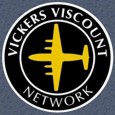
March 1955 to November 1958
Trans-Canada Air Lines (TCA)
CF-TGL - c/n 43 - a V.724 series Viscount
Canada registered
November 1952
An order was placed by Trans-Canada Air Lines (TCA) for fifteen Type 724 aircraft at a total cost of Can$11,500,000. This was the fourth one built.
Production Aircraft No. 49 - the 49th production Type 700 series Viscount built,
was the 17th Viscount fuselage assembled at Hurn, Bournemouth, Hampshire, England,
and the 22nd Viscount assembled at Hurn, Bournemouth, Hampshire, England.
Production Order No. F04/724. Sales Order No. F04/51B. Stock Order No. F08/21B.
9 July 1954
Fuselage assembly commenced at Hurn Airport, Bournemouth, Hampshire, England.
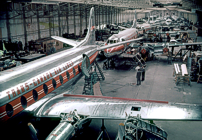
Erecting Shop 'E' at Hurn,
Bournemouth, Hampshire, England
29 August 1954
Fuselage to Erecting Shop 'E' at Hurn Airport, Bournemouth, Hampshire, England.
13 February 1955
First flight from Hurn Airport, Bournemouth, Hampshire, England.
It was fitted with Rolls-Royce Dart RDa3 Mark 506 engines.
8 March 1955
Aircraft passed off by TCA Contracts Inspector William 'Bill' Bird as completed and ready for delivery.
Bill was based at Wisley and had been flown down in a Vickers DH Dove or Heron.
9 March 1955
Departed from Hurn Airport, Bournemouth, Hampshire, England at 15:30 local time on delivery to Trans-Canada Air Lines (TCA) with fleet number '604'.
The delivery crew were Captain Colin C Allen, First Officer Peter Marsh, Navigator / Radio-Operators Bill Bower and George Wood, Flight Engineer Bob Rampling and two supernumeraries - Willy Thomas, a Vickers electrical specialist on his way to Winnipeg for liaison duties with TCA, and writer Robert J Blackburn.
After refuelling at Prestwick Airport, Ayrshire, Scotland it then departed at 18:22 local time to Keflavik Airport, Iceland (743 nautical miles) where it stopped for five nights.
The delay was caused by bad weather further west.
14 March 1955
Departed from Keflavik Airport, Iceland at 12:58 local time to Bluie West One (BW1) Airfield, Narsarsuaq, Southern Greenland (804 nautical miles) arriving at 13:02 local time.
BW1 was built during WWII to assist the transfer of military aircraft from North America to Europe and was opened in January 1942.
Departed from Bluie West One (BW1) Airfield at 15:20 local time to Goose Bay Airport, Newfoundland & Labrador, Canada (672 nautical miles) arriving at 18:23 local time.
Departed from Goose Bay Airport at 19:29 local time to Dorval Airport, Montreal, Province of Quebec, Canada (810 nautical miles), arriving at 21:18 local time.
The aircraft then went to Winnipeg Airport, Manitoba, Canada.
The cabin seating was installed in Canada, as the seats used by TCA were of American manufacture.
The cabin was fitted out with 40 seats which was a reduction from the original 48 seat specification and provided more leg room.
This was heavily marketed and resulted in a high load factor compared to the 18 seat Douglas DC-3 that it replaced on some routes.
FURTHER READING
The diary of the CF-TGL delivery flight from Hurn Airport, Hampshire, England to Dorval Airport, Montreal, Canada
by Robert J Blackburn
 Click to read the Robert J Blackburn diary Click to read the Robert J Blackburn diary
21 March 1955
TCA issued technical instruction V-05.04-1/1 to apply the word 'Viscount' to the tail section in 8.5 inch high red letters edged in white at the first opportunity.
2 June 1955
TCA issued technical instruction V-31.02-2/5 to apply the word 'Viscount' to the inside of the passenger loading door in 4 inch high red letters edged in white at the first opportunity.
July 1956
Cabin interior changed to a two class 44 seat arrangement.
10 July 1957
TCA issued instructions that all Viscounts would be repainted in a 'White Top' livery when a suitable maintenance period became available.
5 June 1958
Scheduled to enter the Winnipeg Airport, Manitoba, Canada TCA maintenance facility for the replacement of the life expired wing lower inner spar boom at approximately 5960 landings for this component. This usually took 28 working days to complete.
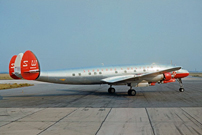
Seaboard & Western
Super Constellation N6503C
10 November 1958
Damaged beyond repair by fire after being hit by Seaboard & Western Lockheed 1049D Super Constellation freighter N6503C named as 'Paris Airtrader'.
At about 11:00 hours local time the Super Constellation was just airborne from runway 31R at Idlewild Airport, New York, USA on a training flight when it became uncontrollable, landed and veered off across the airport and struck the TCA Viscount which was standing at a gate.
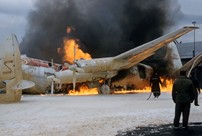
Idlewild crash scene
The now out of control Super Constellation crossed a taxi-way and two perimeter strips, and entered a position on the terminal parking area where it collided with the TCA Viscount, which was standing at Gate 5 and eight minutes away from boarding its passengers for a scheduled departure.
Stewardesses Jeanine Bedard and Karin Foch on board the Viscount in the rear galley were alerted by the cries from people on the ramp and the noise of the approaching Constellation, so they departed their aircraft as rapidly as possible.
The Super Constellation crew consisted of Captains Ralph Neary and Henry Van Nuys, co-pilot Bill Dodds, flight engineer Harold 'Tippy' Ferrara and one other (name unknown).
After the aircraft stopped they all escaped by jumping from the main cabin door which was approximately four feet above ground level. Fire-fighting personnel had already arrived at the scene and were directing a coverage of foam toward this exit at the time.
Bill Dodds received minor burn injuries on a hot door handle and TCA Stewardess Jeanine Bedard fell and cut her forehead while running away from her aircraft.
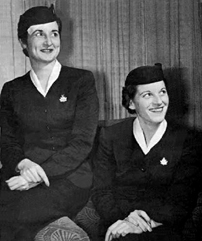
Lucky TCA Stewardesses
Both aircraft were written off due to the extensive fire damage. The Viscount also received extensive axe damage to the rear of the Viscount's cabin due to the fire department gaining access, presumably to make sure that there were no more persons on board.
CAUSE:
An uncommanded propeller pitch reversal occurred during the takeoff run of the Super Constellation. The propeller defect was caused by the incorrect overhaul procedure employed by the propeller manufacturer.
Total time 8,950 hours and 7,455 total landings.
Broken up for scrap.
|

